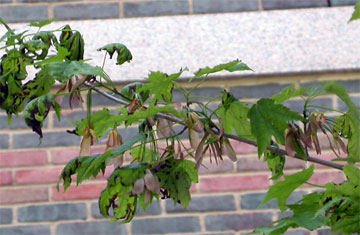Seeing Spots? Recent Weather Favors Foliar Diseases on Trees
By Rochester City Forester, Jacob Ryg. For additional information call 507-328-2515 or email Jacob Ryg.
Are leaves dropping from your maple tree? Are you seeing spots on the basswood leaves? Does the sycamore in your yard look scraggly?
Blame the cool, wet weather during May—perfect conditions for a population explosion among a group of closely related fungi that cause diseases collectively known as anthracnose. Most common on maple, sycamore, ash, oak and dogwood, anthracnose may also affect include linden (basswood), birch and hickory.
Symptoms of anthracnose
Anthracnose fungi often cause leaf drop of maple, oak, sycamore and occasionally linden and birch. Leaf drop is common if prolonged cool wet weather occurs while the new leaves are expanding—exactly the conditions southern New Hampshire experienced earlier this spring.
Other symptoms of anthracnose include dark, discolored areas along the veins or margins of the leaves, brown or black areas between the veins and leaf spots. Twig cankers and twig death are common on sycamore and dogwood trees. Leaf drop and twig death often gives sycamore a scraggly appearance with tufts of leaves at the end of otherwise bare branches. Many trees that drop leaves in June will put out a second flush of scattered, large leaves.
Other leaf spot diseases prevalent
In addition to anthracnose, a wide range of other fungal leaf spot diseases have appeared on lilacs, rhododendrons, azaleas, crabapples, and many other trees and shrubs this year. Because many of the same diseases were present last year (thanks to similar weather last spring), dead twigs and fallen leaves provided the source of infections for this year. Add in the wet weather this year and viola! you basically have what Extension forester Marshall Patmos calls a “giant Petri dish” of foliar diseases.
What to do
Although it may be alarming to see all the dead leaves on the ground beneath your maple, or the spotted leaves on your crabapple, anthracnose and leaf spots are generally considered a cosmetic or aesthetic problem that rarely requires chemical control.
Chemicals applied now for anthracnose and most leaf spots will do little to control the diseases. The symptoms now visible were caused by infections that occurred when the leaves were expanding, and these established infections can’t be “cured.” Rarely are fungicides warranted as protection from infection in the early spring.
In fact, spraying large trees is not only impractical but also often unnecessary, since many healthy leaves remain on the tree.
Fungicides are warranted only in severe cases where defoliation has occurred for three or more years. (One exception: anthracnose in flowering dogwood, which often requires fungicides for effective control.)
Management of anthracnose and leaf spots generally includes pruning infected twigs and cultural practices that improve tree vigor and prevent stress. These include fertilization after the leaves have fallen in the autumn or one month before the last frost in the spring will help maintain tree vigor. Raking and removing leaves in the autumn helps control many of the leaf spots but has minimal effect on anthracnose.
It’s important to remember that trees are resilient and leaf spots and anthracnose are just another part of the natural challenges Mother Nature exposes them to.
